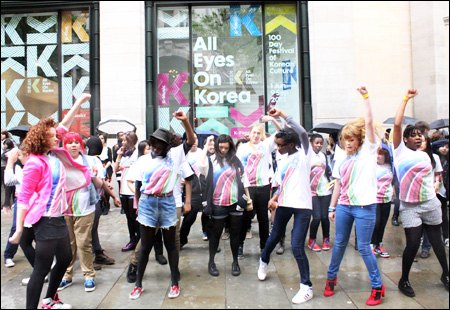
‘Hallyu’ — Korean teaching tool

Super Junior, ‘Winter Sonata’ as new primers
NEW YORK ― For learners of Korean in the U.S., it’s goodbye to rote memorization and dull drills; hello to Super Junior and Bae Yong-joon. A new curriculum is set to revamp the traditional teaching method of Korean, a much-needed update aimed at giving the language a more fun and practical appeal.
“It’s always been about grammar and vocabulary, just like the way Korean students approach English,’’ said Lee Hyo-sang, associate professor in the Department of East Asian Languages and Cultures at Indiana University.
“You can pile on all the grammar and vocabulary you want, but it’s worthless if you can’t speak the language,’’ he said. “What you know about the language isn’t important. What you can do with the language is.’’
To help Korean learners do more, Lee and members of the American Association of Teachers of Korean (AATK), a national group of Korean language educators in the U.S., are working on a new curriculum that moves away from textbooks and engages cultural elements instead.
“Many instructors have found existing textbooks to be very limited. Those are bound to be more and more outdated, and lack in authenticity and topical appeal for college students,’’ says Kim Hae-young, associate professor in the Department of Asian and Middle Eastern Studies at Duke University and President of AATK.
Currently, approximately 70 middle and high schools, and 93 colleges and universities in the U.S. offer Korean classes.
Experts say there has been a sharp rise in the number of students who take Korean classes on US campuses largely driven by “hallyu,’’ or the Korean wave.
So then what better way to teach Korean than with Korean drama and music?
“K-pop and K-drama are primarily what drew these students to the language, so it will be a more enjoyable and effective learning process to integrate the elements they like,’’ says Lee.
For example, lyrics could be used to illustrate grammatical patterns and functions. In Super Junior’s “Beautiful Woman,’’ the lyrics show a repetition of phrases, such as “bolkka malkka’’ (should I look or not) and “bonchae manchae’’ (as if I saw it or not), which can make a complex structure easier to understand.
At AATK’s recent annual conference at Stanford University, Susan Strauss of Pennsylvania State University introduced comparison clips from the popular drama “Winter Sonata’’ and American hit series “Dawson’s Creek,’’ a lesson to guide students to explore similarities and differences of melodramatic depiction of romantic love and jealousy in each.
“We’re not looking for replacement of old textbooks with newer `textbooks,’’’ says Kim. “Printed books are not suitable forms for updating, revising and flexible adaptations, so different ways of making developed materials need to be tried.’’
The new curriculum is expected to take at least two to three years for completion. Once completed, it will become a national standard as outlined by the American Council on the Teaching of Foreign Languages, a national advocacy group for language teachers. <The Korea Times/Jane Han>


